Taixia Shi
Dual-functional microwave photonic system for concurrent radar and secure communication via radar signal masking
Nov 28, 2024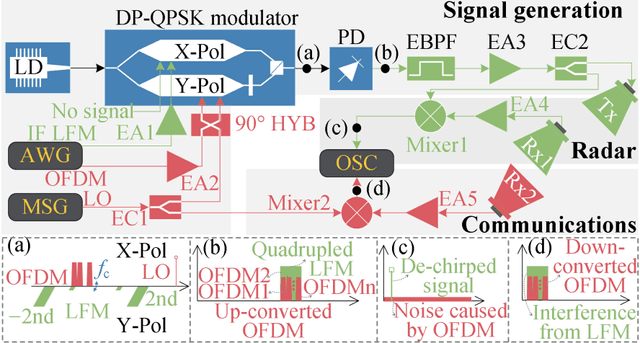

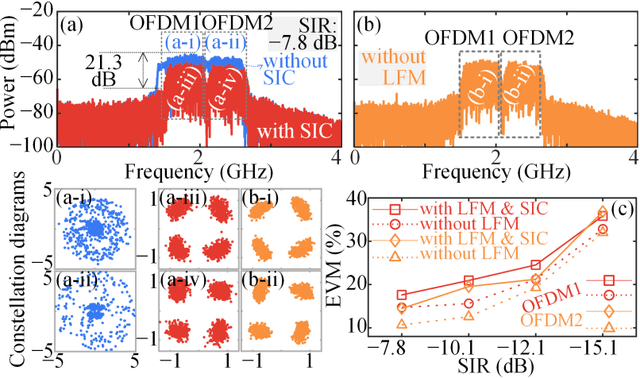
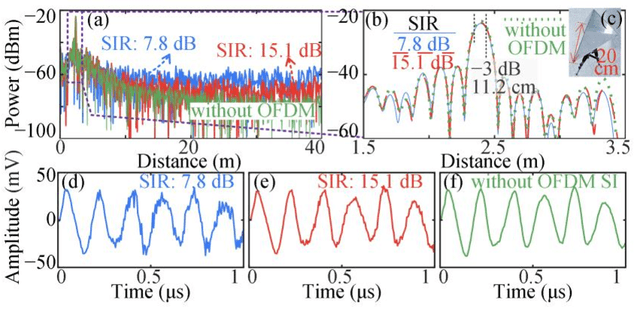
Abstract:Integrating functions such as radar and communication into a single system is of great significance for the miniaturization and functional integration of future electronic warfare and 6G systems. Here, we show a dual-functional microwave photonic system for concurrent radar and secure communication. The scheme utilizes microwave photonic frequency multiplying and frequency conversion techniques to shift both the intermediate frequency radar and communication signals to the same frequency band, enabling radar and communication operations at the same time and frequency. The high-power radar signal is also used to mask the communication signal, increasing the difficulty of signal interception and thus enhancing security. By employing de-chirping at the radar receiver and self-interference cancelation at the communication receiver, the radar function can be implemented and the communication signal can also be correctly demodulated after removing the radar masking. An experiment is performed. A 0.3-GHz bandwidth linearly frequency-modulated signal is quadrupled and superimposed with two up-converted 0.5-Gbaud orthogonal frequency-division multiplexing signals. A communication data rate of 2 Gbit/s, a radar ranging measurement error of less than $\pm$ 0.3 cm, and a radar inverse synthetic aperture radar imaging resolution of 12.5$\times$10.2 cm are achieved.
Physical encryption and decryption for secure data transmission in optical networks leveraging the temporal Talbot effect and microwave photonics
Jul 12, 2024Abstract:A novel microwave photonic scheme for secure data transmission in optical networks is proposed. The security of the scheme is guaranteed by physical encryption and decryption via the temporal Talbot effect in dispersive mediums. First, the original data is randomized in the digital domain by performing an exclusive OR operation using a random matrix. Subsequently, a time-varying multi-tone electrical signal, which represents the randomized data matrix, is modulated onto an optical carrier. The optical signal after modulation is then phase-modulated by a temporal Talbot array illuminator (TAI) signal, and the optical signal after discrete quadratic phase modulation will lose its original appearance in the frequency domain and be further dispersed in the first dispersive medium. Due to the dispersion that does not match the TAI signal exactly, the waveform after the first dispersive medium is a noise-like signal. Hence, the physical encryption of the original data is successfully achieved. As the optical signal passes a second dispersive medium that makes the total dispersion match the TAI signal, the temporal waveform of the noise-like signal after photodetection is transformed into pulses. "1" and "0" in the randomized data matrix are represented through the presence and absence of pulses, and the physical decryption is achieved. By further processing the recovered data matrix using the random matrix, the original data can be recovered. The physical layer security of the proposed scheme and its fiber transmission capability are demonstrated. 8-Gbit/s data is transmitted, encrypted, and decrypted using two dispersive mediums and an optical fiber of 10 to 200 km, and error-free transmission is achieved. Many factors that affect the encryption, decryption, and transmission performance of the system have been analyzed.
A microwave photonic prototype for concurrent radar detection and spectrum sensing over an 8 to 40 GHz bandwidth
Jun 20, 2024



Abstract:In this work, a microwave photonic prototype for concurrent radar detection and spectrum sensing is proposed, designed, built, and investigated. A direct digital synthesizer and an analog electronic circuit are integrated to generate an intermediate frequency (IF) linearly frequency-modulated (LFM) signal with a tunable center frequency from 2.5 to 9.5 GHz and an instantaneous bandwidth of 1 GHz. The IF LFM signal is converted to the optical domain via an intensity modulator and then filtered by a fiber Bragg grating (FBG) to generate only two 2nd-order optical LFM sidebands. In radar detection, the two optical LFM sidebands beat with each other to generate a frequency-and-bandwidth-quadrupled LFM signal, which is used for ranging, radial velocity measurement, and imaging. By changing the center frequency of the IF LFM signal, the radar function can be operated within 8 to 40 GHz. In spectrum sensing, one 2nd-order optical LFM sideband is selected by another FBG, which then works in conjunction with the stimulated Brillouin scattering gain spectrum to map the frequency of the signal under test to time with an instantaneous measurement bandwidth of 2 GHz. By using a frequency shift module to adjust the pump frequency, the frequency measurement range can be adjusted from 0 to 40 GHz. The prototype is comprehensively studied and tested, which is capable of achieving a range resolution of 3.75 cm, a range error of less than $\pm$ 2 cm, a radial velocity error within $\pm$ 1 cm/s, delivering clear imaging of multiple small targets, and maintaining a frequency measurement error of less than $\pm$ 7 MHz and a frequency resolution of better than 20 MHz.
Microwave photonic short-time Fourier transform based on stabilized period-one nonlinear laser dynamics and stimulated Brillouin scattering
Apr 17, 2024Abstract:A microwave photonic short-time Fourier transform (STFT) system based on stabilized period-one (P1) nonlinear laser dynamics and stimulated Brillouin scattering (SBS) is proposed. By using an optoelectronic feedback loop, the frequency-sweep optical signal generated by the P1 nonlinear laser dynamics is stabilized, which is further used in conjunction with an optical bandpass filter implemented by stimulated Brillouin scattering (SBS) to achieve the frequency-to-time mapping of microwave signals and the final STFT. By comparing the experimental results with and without optoelectronic feedback, it is found that the time-frequency diagram of the signal under test (SUT) obtained by STFT is clearer and more regular, and the frequency of the SUT measured in each frequency-sweep period is more accurate. The mean absolute error is reduced by 50% under the optimal filter bandwidth.
Seamlessly merging radar ranging/imaging, wireless communications, and spectrum sensing, for 6G empowered by microwave photonics
Apr 08, 2024



Abstract:Integration of radar, wireless communications, and spectrum sensing is being investigated for 6G with an increased spectral efficiency. Microwave photonics (MWP), a technique that combines microwave engineering and photonic technology to take advantage of the wide bandwidth offered by photonics for microwave signal generation and processing is considered an effective solution for the implementation of the integration. In this paper, an MWP-assisted joint radar, wireless communications, and spectrum sensing (JRCSS) system that enables precise perception of the surrounding physical and electromagnetic environments while maintaining high-speed data communication is proposed and demonstrated. Communication signals and frequency-sweep signals are merged in the optical domain to achieve high-speed radar ranging and imaging, high-data-rate wireless communications, and wideband spectrum sensing. In an experimental demonstration, a JRCSS system supporting radar ranging with a measurement error within $\pm$ 4 cm, two-dimensional imaging with a resolution of 25 $\times$ 24.7 mm, wireless communications with a data rate of 2 Gbaud, and spectrum sensing with a frequency measurement error within $\pm$ 10 MHz in a 6-GHz bandwidth, is demonstrated.
Channelized analog microwave short-time Fourier transform in the optical domain with improved measurement performance
May 25, 2023



Abstract:In this article, analog microwave short-time Fourier transform (STFT) with improved measurement performance is implemented in the optical domain by employing stimulated Brillouin scattering (SBS) and channelization. By jointly using three optical frequency combs and filter- and SBS-based frequency-to-time mapping (FTTM), the time-frequency information of the signal under test (SUT) in different frequency intervals is measured in different channels. Then, by using the channel label introduced through subcarriers after photodetection, the obtained low-speed electrical pulses in different channels mixed in the time domain are distinguished and the time-frequency information of the SUT in different channels is respectively obtained and spliced to implement the STFT. For the first time, channelization measurement technology is introduced in the STFT system based on frequency sweeping and FTTM, greatly reducing the frequency-sweep range of the required frequency-sweep signal to the analysis bandwidth divided by the number of channels. In addition, channelization can also be used to improve the time and frequency resolution of the STFT system. A proof-of-concept experiment is performed. 12-GHz and 10-GHz analysis bandwidth is implemented by using a 4-GHz frequency-sweep signal and 3 channels and a 2-GHz frequency-sweep signal and 5 channels. Measurement performance improvement is also demonstrated.
Photonics-assisted analog wideband self-interference cancellation for in-band full-duplex MIMO systems with adaptive digital amplitude and delay pre-matching
Aug 03, 2022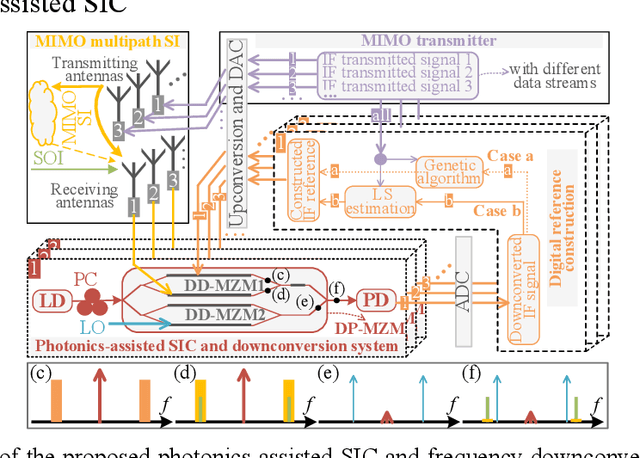

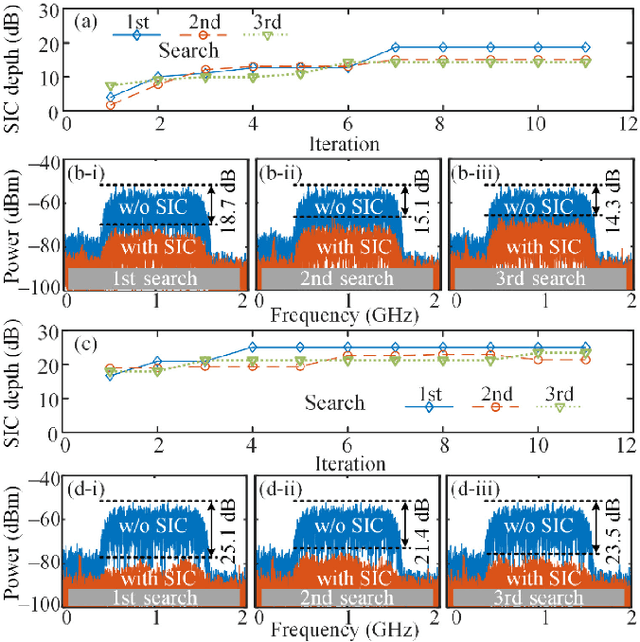

Abstract:A photonics-assisted analog wideband RF self-interference (SI) cancellation and frequency downconversion approach for in-band full-duplex (IBFD) multiple-input multiple-output (MIMO) systems with adaptive digital amplitude and delay pre-matching is proposed based on a dual-parallel Mach-Zehnder modulator (DP-MZM). In each MIMO receiving antenna, the received signal, including different SI signals from different transmitting antennas and the signal of interest, is applied to one arm of the upper dual-drive Mach-ehnder modulator (DD-MZM) of the DP-MZM, the reference signal is applied to the other arm of the upper DD-MZM, and the local oscillator signal is applied to the lower DD-MZM. The SI signals are canceled in the optical domain in the upper DD-MZM and the frequency downconversion is achieved after photodetection. To cancel the SI signals, the reference signal is constructed in the digital domain, while the amplitude and delay of the constructed reference are adjusted digitally by upsampling with high accuracy. Experiments are performed when two different SI signals are employed. The genetic algorithm and least-squares algorithm are combined with segmented searching respectively for the SI signal reconstruction and amplitude and delay pre-matching. A cancellation depth of around 20 dB is achieved for the 1-Gbaud 16 quadrature-amplitude modulation orthogonal frequency-division multiplexing signal.
Photonics-based de-chirping and leakage cancellation for frequency-modulated continuous-wave radar system
Nov 12, 2021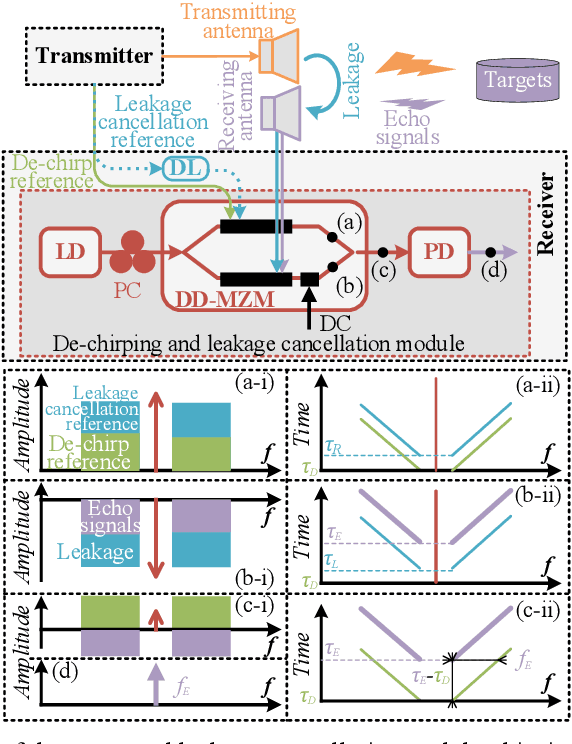
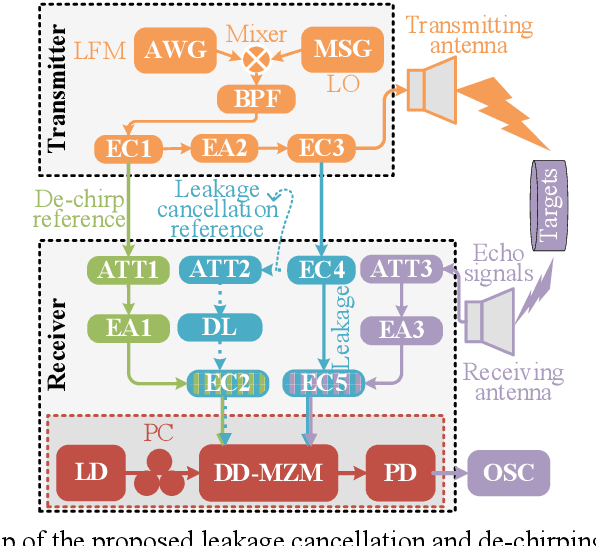
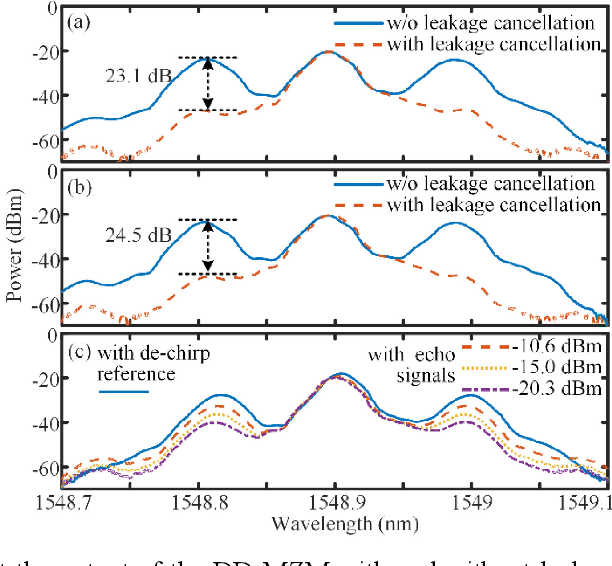
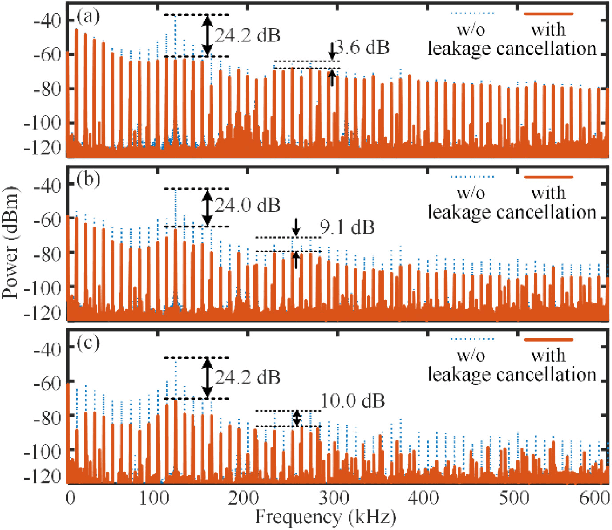
Abstract:A photonics-based leakage cancellation and echo signal de-chirping approach for frequency-modulated continuous-wave radar systems is proposed based on a dual-drive Mach-Zehnder modulator (DD-MZM), with its performance evaluated by the radar measurement and imaging. The de-chirp reference signal and the leakage cancellation reference signal are combined and applied to the upper arm of the DD-MZM, while the received signal including the leakage signal and echo signals is applied to the lower arm of the DD-MZM. When the amplitudes and delays of the leakage cancellation reference signal and the leakage signal are precisely matched and the DD-MZM is biased at the minimum transmission point, the leakage signal is canceled in the optical domain. The de-chirped signals are obtained after the leakage-free optical signal is detected in a photodetector. An experiment is performed. The cancellation depth of the de-chirped leakage signal is around 23 dB when the center frequency and bandwidth of the linearly frequency-modulated signal are 11.5 and 2 GHz. The leakage cancellation scheme is used in a radar system. When the leakage cancellation is not employed, the leakage signal will seriously affect the imaging results and distance measurement accuracy of the radar system. When the leakage cancellation is applied, the imaging results of multiple targets can be clearly distinguished, and the error of the distance measurement results is significantly reduced to 10 cm.
Digital-assisted photonic analog wideband multipath self-interference cancellation
Nov 12, 2021
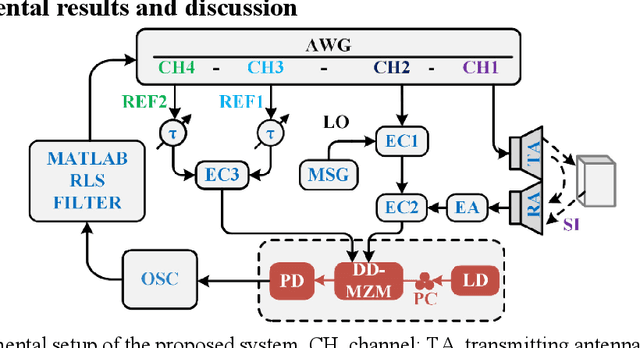


Abstract:A digital-assisted photonic analog wideband radio-frequency multipath self-interference cancellation (SIC) and frequency downconversion method based on a dual-drive Mach-Zehnder modulator and the recursive least square (RLS) algorithm is proposed and demonstrated for in-band full-duplex systems. Besides the reference for the direct-path self-interference (SI) signal, the RLS algorithm is used to construct another reference for the residual SI signal from the direct path and the SI signals from the reflection paths. The proposed method can solve the performance limitation in the previously reported SIC methods of constructing the multipath SI signal using a single reference caused by the limited dynamic range of the digital-to-analog converter when the direct-path SI signal is much stronger than the sub-weak reflection-path SI signals. An experiment is performed. When the carrier frequency of the multipath SI signal is 10 GHz and the direct-path SI signal is much stronger than the sub-weak multipath SI signal, the cancellation depths of about 26.7 and 26.1 dB are realized with SI baud rates of 0.5 and 1 Gbaud. When the direct-path SI signal and sub-weak multipath SI signal own closer power, the corresponding cancellation depths are 24.7 and 20.8 dB, respectively.
Photonics-assisted wideband RF self-interference cancellation with digital domain amplitude and delay pre-matching
Sep 07, 2021



Abstract:A photonics-based digital and analog self-interference cancellation approach for in-band full-duplex communication systems and frequency-modulated continuous-wave radar systems is reported. One dual-drive Mach-Zehnder modulator is used to implement the analog self-interference cancellation by pre-adjusting the delay and amplitude of the reference signal applied to the dual-drive Mach-Zehnder modulator in the digital domain. The amplitude is determined via the received signal power, while the delay is searched by the cross-correlation and bisection methods. Furthermore, recursive least squared or normalized least mean square algorithms are used to suppress the residual self-interference in the digital domain. Quadrature phase-shift keying modulated signals and linearly frequency-modulated signals are used to experimentally verify the proposed method. The analog cancellation depth is around 20 dB, and the total cancellation depth is more than 36 dB for the 2-Gbaud quadrature phase-shift keying modulated signals. For the linearly frequency-modulated signals, the analog and total cancellation depths are around 19 dB and 34 dB, respectively.
 Add to Chrome
Add to Chrome Add to Firefox
Add to Firefox Add to Edge
Add to Edge